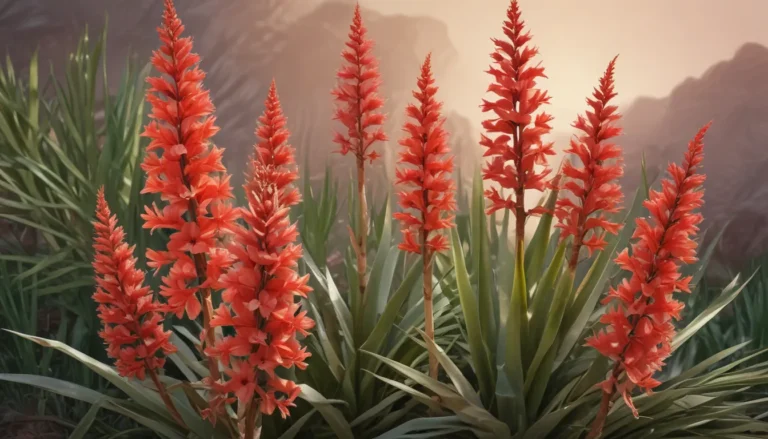The pictures we use in our articles might not show exactly what the words say. We choose these pictures to make you interested in reading more. The pictures work together with the words but don’t take their place. The words still tell you the important facts.
Welcome to the captivating realm of Gloriosa Lily, a mesmerizing flower that has intrigued plant enthusiasts for centuries. Known for its unique appearance, vibrant colors, and stunning beauty, this climbing vine, also called Gloriosa superba or Flame Lily, is truly a star in the garden. Dive into the hidden treasures of this extraordinary plant as we uncover 11 surprising facts that will leave you amazed and eager to learn more. From its symbolic meanings to its endangered status and medicinal properties, join us on a journey of discovery to unravel the secrets of the Gloriosa Lily.
Key Takeaways:
- Gloriosa Lily, a.k.a. Flame Lily, is a captivating climbing vine with toxic properties, cultural significance, and low-maintenance care requirements. It symbolizes pride and glory, attracts pollinators, and is a rare and endangered species. From its medicinal uses to its resemblance to a flame, this flower is truly a gem in the world of flora.
- The vibrant Gloriosa Lily, the national flower of Zimbabwe, can be easily grown from seeds or tubers, making it a versatile addition to any garden. With conservation efforts in place to protect this beautiful flower, its unique charm continues to shine bright.
The Fascinating Flame Lily:
The Gloriosa Lily, scientifically known as Gloriosa superba, earns its nickname "Flame Lily" from its striking red and yellow petals. This climbing vine, native to tropical regions of Africa and Asia, enchants with its vibrant hues and elegant floral display.
A Climbing Marvel:
Surprisingly, the Gloriosa Lily is not just a flower but a climbing vine able to reach heights of up to 6 feet. With its tendrils that grasp onto structures, it is a popular choice for trellises and fences, adding a touch of elegance to any garden.
Beware of Toxicity:
While its beauty is captivating, handling the Gloriosa Lily requires caution as it contains toxic compounds, especially in its roots and tubers. Ingestion can lead to symptoms like vomiting and diarrhea, emphasizing the importance of being mindful around this exquisite plant.
A Flame-Like Appearance:
True to its name, the Gloriosa Lily boasts flowers that resemble flames with elongated petals in vibrant red and yellow hues. This unique color combination and shape make it a stunning focal point in any garden or floral arrangement.
Symbolism of Pride and Glory:
In various cultures, the Gloriosa Lily symbolizes qualities of pride, glory, and admiration. Its fiery colors and graceful form evoke a sense of strength and resilience, embodying the essence of these noble virtues.
National Flower of Zimbabwe:
Holding the prestigious title of the national flower of Zimbabwe, the Gloriosa Lily further underscores its cultural significance and representation of national pride. Its symbolic importance speaks volumes about the admiration it garners.
Medicinal Uses:
Deep-rooted in traditional medicine, the Gloriosa Lily is believed to possess medicinal properties in its tubers and leaves. With historical uses in treating conditions like arthritis, gout, and snake bites, this plant offers a blend of beauty and healing potential.
Pollinator Magnet:
The vibrant colors and nectar-rich blooms of the Gloriosa Lily attract a plethora of pollinators, including butterflies and bees. This makes it a valuable addition to any garden for supporting and nourishing these essential insects.
Low-Maintenance Elegance:
Surprisingly, the Gloriosa Lily is relatively easy to grow and care for, thriving in well-drained soil, full sun, and warm climates. Requiring minimal watering once established, it proves to be a hassle-free and rewarding addition to any gardener's collection.
Propagation Made Simple:
Whether you prefer seeds or tubers, propagating the Gloriosa Lily is a straightforward process. With seeds sown in pots or directly in the garden and tubers divided to create new plants, you can easily expand your collection of these captivating flowers.
Rarity and Conservation:
Despite its allure, the Gloriosa Lily faces the harsh reality of being a rare and endangered species in the wild. Factors like habitat loss and overharvesting have taken a toll on its population, prompting conservation efforts to safeguard and preserve this exquisite flower.
Embrace the Beauty of Gloriosa Lily:
In conclusion, the Gloriosa Lily stands out as a unique and captivating plant that continues to mesmerize with its beauty and intriguing attributes. Whether you're drawn to its stunning colors, its symbolic meanings, or its ease of care, this climbing vine offers a blend of elegance and fascination. By incorporating Gloriosa Lily into your garden or floral displays, you can infuse a touch of enchantment and allure into any setting. Explore the wonders of this remarkable plant and immerse yourself in the delights it has to offer.
FAQs About Gloriosa Lily:
- Scientific Name: Gloriosa superba
- Origin: Tropical and subtropical regions of Africa and Asia
- Height: Up to 6 feet tall
- Toxicity: Poisonous to humans and pets; handle with care
- Container Growing: Suitable for balconies and small spaces
- Watering: Regular watering to keep soil evenly moist
- Propagation: Seeds or tubers can be used
- Medicinal Uses: Traditional remedies for arthritis, gout, and infertility
- Frost Protection: Sensitive to frost; grow in warm, protected areas
- Sunlight: Thrives in full sun but tolerates partial shade
- Blooming Season: Typically blooms in summer
Unravel the beauty and mysteries of Gloriosa Lily, a mesmerizing flower with a story to tell. From its toxic properties to its symbolic meanings and conservation status, this climbing vine captures the hearts of those who appreciate its allure. Discover more about the unique climbing habits, cultural significance, and low-maintenance care requirements of this rare and endangered species. Embrace the enchanting world of Gloriosa Lily and witness the wonders it brings to gardens and floral arrangements worldwide.






